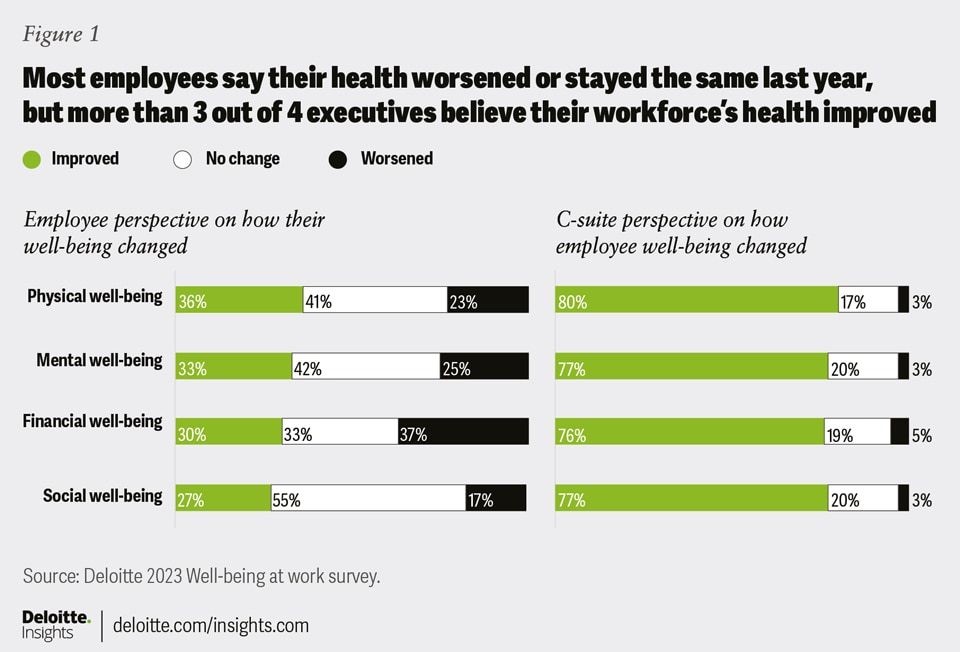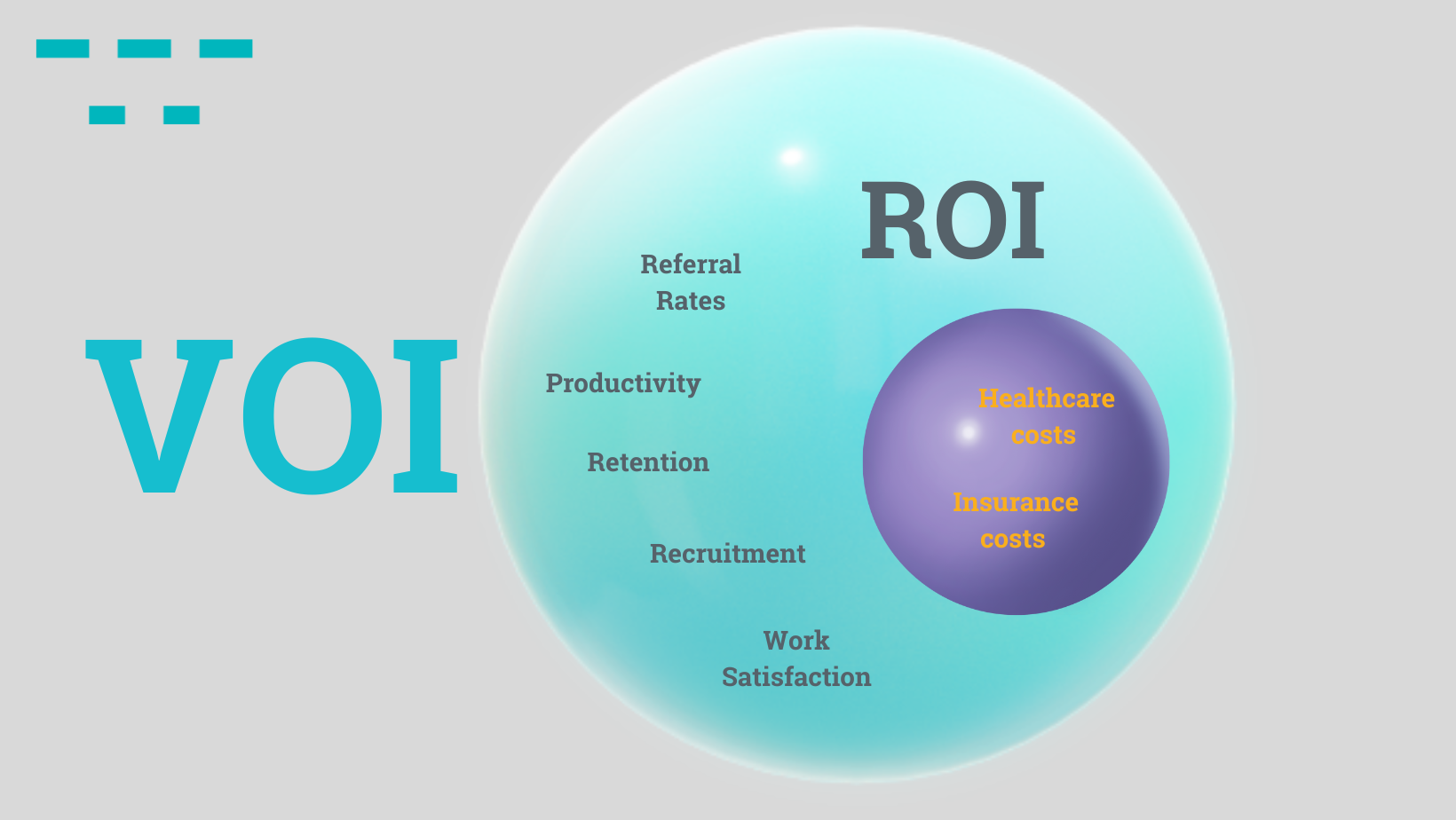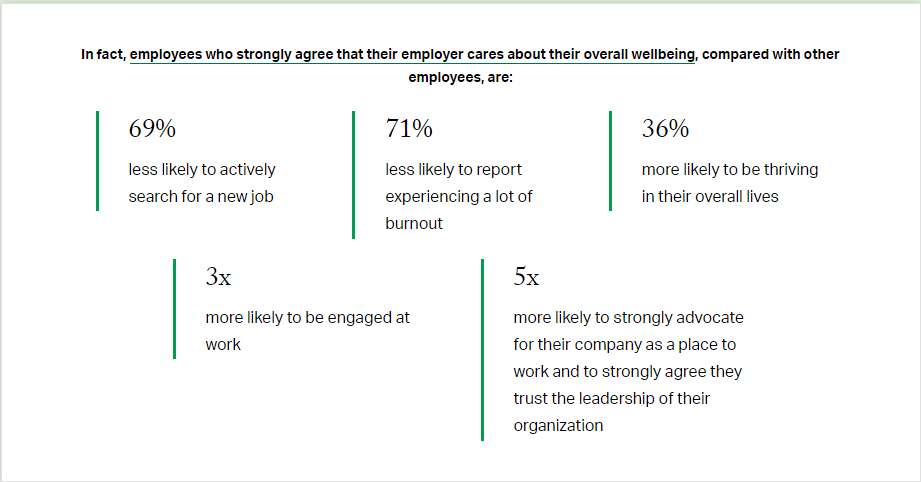The year 2023 left an undeniable mark on the global workforce. From pandemic aftershocks to economic uncertainties, employees navigated a complex landscape that stretched their resilience and redefined expectations. As we step into 2024, a critical question lingers: how "well" are your employees doing?
Was 2023 A Workforce Odyssey? Adapting to Change Amidst Pandemic Waves and Economic Tremors
The year 2023 proved to be a tumultuous journey for the global workforce, as employees grappled with the aftermath of the pandemic and economic uncertainties. The search results shed light on the key challenges and transformations that unfolded during this time.
The COVID-19 pandemic continued to impact the global workforce, with evolving return-to-office policies, higher employee turnover, and burned-out employees. Amid a looming economic downturn, employers faced another tumultuous year. However, organizations that anchored themselves with empathy and equipped their teams to navigate through these turbulent waters were better positioned to thrive.
One of the most significant trends shaping work in 2023 was the rise of hybrid flexibility, with employees continuing to expect flexible, hybrid, and remote working arrangements. The democratisation of technology, digitisation, and automation of work contributed to the increase in remote and hybrid work options, challenging employers to create a human-centric approach to hybrid work. This shift is expected to have significant impacts on social, cultural, and IT infrastructures.
Another trend was the "quiet hiring" of in-demand talent, with employers seeking to retain their most talented workers in a competitive job market. The State of the Global Workplace Report highlighted an increase in job opportunities, signaling that the world economy is open for business. However, over half of employees were actively or passively seeking new job opportunities, making talent retention a critical issue for employers.
The workforce of 2023 was also characterized by changing skillsets, with the manufacturing industry leading the way in leveraging augmented or virtual reality devices for workforce instruction and training. The evolved workforce enabled significant benefits, including resilience, faster training, and the ability to change worker skillsets more rapidly.
Employee Wellbeing in 2023: A Review
2023 was a year etched in the annals of history, not just for its global events, but also for the profound impact it had on employee wellbeing. As the world grappled with the lingering effects of the pandemic and a shaky economy, employees found themselves navigating a challenging new normal.
The state of employee wellbeing in 2023 reflects a continued emphasis on holistic wellness, with organizations expecting employees to achieve more with fewer resources.
The most common stressors for employees were an overwhelming workload, difficulty balancing work and life, and job insecurity. A recent survey by the World Economic Forum has revealed a worrying decline in employee wellbeing in 2023. Despite 80% of C-suite executives believing that workplace wellbeing has improved, only a third of employees reported an improvement in their mental and physical health. This disconnect highlights a significant gap between perception and reality, suggesting that companies need to do more to address the well-being of their employees.
The survey, which questioned over 14,000 employees and 300 C-suite executives, found that employees are feeling increasingly stressed, exhausted, and overwhelmed. This is likely due to several factors, including the ongoing COVID-19 pandemic, economic uncertainty, and a culture of overwork.

A recent survey by the Employee Benefit Research Institute (EBRI) paints a concerning picture of employee well-being in 2023. The report, titled "2023 Workplace Wellness Survey Finds 74 Percent of American Workers Are Moderately or Highly Concerned About Their Workplace Well-Being," highlights various stressors impacting employees and the need for organizations to prioritize well-being initiatives.
“ A staggering 74% of American workers expressed moderate or high concerns about their workplace well-being, with 29% reporting being highly concerned.
Understanding Employee Well-being
More than just physical health, employee well-being is a multi-faceted experience encompassing social, physical, mental, and financial well-being. Employee well-being refers to the state of being healthy, happy, and fulfilled in one's work and personal life. It encompasses various dimensions, including social, physical, mental, and financial well-being.
Social well-being: This refers to an individual's sense of belonging, connection, and positive relationships with colleagues, managers, and the broader work community. Feeling supported and valued by peers fosters a sense of security and contributes to overall well-being.
Physical well-being: Encompassing healthy habits, access to healthcare, and a balance between work and physical activity. Organizations can promote physical well-being through ergonomic workspace design, wellness programs, and flexible work arrangements that encourage breaks and exercise.
Mental well-being: This involves an individual's emotional and psychological state. Factors like stress management, work-life balance, and addressing potential burnout are crucial for mental well-being. Organizations can provide mental health resources, stress management workshops, and create a culture of open communication to support employees.
Financial well-being: This is about feeling secure and in control of one's finances. Financial stress can significantly impact overall well-being and work performance. Organizations can offer competitive compensation, financial literacy programs, and benefits that support financial security.
A holistic approach to employee well-being recognizes the interconnected nature of these dimensions and seeks to address them comprehensively. This approach has significant implications for both employees and organizations.
Why does employee wellbeing matter?
Forget ping pong tables and nap pods. In today's talent-driven marketplace, "happy employees" isn't just a tagline, it's a strategic imperative. It's the difference between coasting by and propelling an organization into the future with innovation, resilience, and sustainable success. But why does employee well-being matter that much?
Employers who care for employee health and wellbeing see numerous measurable benefits, including higher productivity and profitability, lower turnover, and fewer safety incidents.
When employees' wellbeing is thriving, organizations directly benefit, as they take fewer sick days, deliver higher performance, and have lower rates of burnout and turnover.
Employee wellbeing is a key predictor of employee retention and referrals. Employees who experience high levels of wellbeing in the workplace are three times more likely to stay with the company.
Employee Perspective:
Only 25% of U.S. employees strongly agree that their organization cares about their overall wellbeing. Many employees seek employment that contributes to their wellbeing and helps them create work-life balance.
63% of U.S. workers say that having greater work-life balance and better personal wellbeing is very important to them when looking for a job.
When leaders show genuine care and support for their team members' mental and emotional wellbeing, it fosters job satisfaction and loyalty. Employees are more likely to stay with the company, reducing turnover and retaining top talent.
Employee well-being in 2024; the multifaceted puzzle.
As we step into 2024, the conversation around employee well-being continues to evolve, with a growing recognition that it is a complex puzzle with pieces intertwined, each impacting the overall picture.
Today's employees navigate a multifaceted landscape influenced by several factors, including the hybrid work model, mental health concerns, financial anxieties, technological overload, and the search for purpose.
Organizations must understand these challenges and create structures for effective communication, fostering a sense of belonging, and addressing potential burnout. Prioritizing accessible mental health support, creating safe spaces for open conversations, and actively dismantling stigmas are crucial.
Offering competitive compensation, financial wellness programs, and transparent communication about the organization's health can build trust and security. Promoting digital literacy, encouraging tech breaks, and implementing responsible tech practices are essential.
Organizations must clearly articulate their values and mission, provide opportunities for growth and contribution, and empower employees to make a difference.
The focus on employee well-being is at an all-time high, with companies increasingly taking proactive steps to improve their employees' mental wellness, recognizing that it plays a major role in ensuring employee productivity, satisfaction, and retention.
The Business Case for Prioritizing Employee Well-being
The corporate wellness market is booming, on track to hit $100 billion by 2030. This explosion reflects a fundamental shift: employee well-being isn't just nice-to-have, it's a strategic game-changer. It's an investment that pays off in real, tangible ways – boosted productivity, a surge in innovation, and ultimately, a healthier bottom line. So, what's the secret sauce? Let's delve into the compelling business case for prioritizing employee well-being.
-
Value On Investment: The value on investment (VOI) in employee well-being programs goes beyond the traditional return on investment (ROI) by encompassing critical non-financial benefits such as employee engagement, retention, and productivity. While ROI focuses on immediate financial gains, VOI provides a comprehensive perspective on the health and vitality of an employee wellness initiative. It is a cost/effectiveness measure, as opposed to the cost/benefit measure of ROI. VOI benefits go beyond financial metrics and include other factors such as productivity, employee morale, retention, and overall well-being.
- Increased productivity: Reduced stress and absenteeism lead to employees who are more present, engaged, and focused, driving higher output.
- Lower healthcare costs: By promoting healthy habits and addressing stress, organizations can see significant reductions in healthcare expenses.
- Reduced turnover and recruitment costs: When employees feel valued and supported, they're more likely to stay, saving companies costly recruitment and training expenses.
- Enhanced innovation and creativity: Happy and empowered employees are more likely to take risks, share ideas, and collaborate, leading to groundbreaking innovation.
The VOI of well-being programs ends up being the most important outcome, as it reflects the overall health and vitality of the workforce. It is a simpler way of saying that organizations want to find how their wellness programs are impacting the overall well-being and effectiveness of their employees. By focusing on VOI, organizations can gain a more comprehensive understanding of the impact of their well-being programs and make more informed decisions about their workforce's health and productivity.

-
Attracting and Retaining Top Talent: In a talent war, well-being is a powerful weapon. Organizations that prioritize it become magnets for top talent, attracting and retaining the best minds who seek workplaces that nurture their holistic well-being. This competitive edge translates to a stronger team and long-term success.
-
3. Building a Strong Employer Brand: Today's job seekers don't just look for salaries; they research company culture and values. Organizations that prioritize well-being build a strong employer brand known for caring for its people. This attracts talent, fosters positive public perception, and enhances reputation.
-
Fostering Resilience and Agility: The business world is unpredictable. Companies with well-being programs equip their employees with the emotional and mental agility to navigate challenges and changes. This resilience translates to adaptability, faster recovery from setbacks, and a sustainable competitive advantage.
-
Boosting Employee Advocacy: Happy and engaged employees become brand ambassadors, advocating for their organizations within and beyond the workplace. This positive word-of-mouth marketing attracts potential customers and partners, amplifying the company's reach and impact.
Implementing Effective Employee Well-being Programs
Implementing effective employee well-being programs requires careful planning, commitment, and ongoing evaluation. The following steps can help organizations create a comprehensive program that improves employee well-being:
Conduct a thorough assessment of employee needs and preferences: Before implementing a well-being program, it's essential to understand the unique needs and preferences of the workforce. This can be done through focus groups, surveys, and other forms of feedback.
If you need help with this process, Wellics is here to help with a free employee wellbeing audit.Develop a comprehensive wellness plan: A holistic wellness program addresses multiple dimensions of well-being, promoting a healthier and more engaged workforce. Consider offering a range of activities, such as fitness challenges, mindfulness workshops, nutrition counseling, and stress management programs.
Secure leadership support: To ensure the success of a well-being program, it's crucial to secure leadership support. Leaders can help promote the program, allocate resources, and encourage participation.
Communicate effectively: Effective communication is key to the success of a well-being program. Organizations should communicate the program's goals, benefits, and activities clearly and regularly to employees.
Offer incentives: Incentives can help motivate employees to participate in a well-being program. Consider offering rewards such as gift cards, time off, or other incentives to encourage participation.
Evaluate and adjust: Ongoing evaluation is essential to ensure the program's effectiveness and make adjustments as needed. Organizations should regularly collect feedback from employees and use data to make informed decisions about the program's future.
Download Now: Free Guide to Employee Wellness Programs
Forget fleeting trends and one-size-fits-all solutions. As we crack the code on employee well-being in 2024, a groundbreaking paradigm shift emerges. It's not about ticking boxes anymore. It's about igniting innovation, embracing a holistic tapestry of health, and cultivating a culture where employee well-being isn't an afterthought, but the beating heart of the organization.
This transformative journey transcends mere "perks." It's an investment in your most asset - your people. By weaving well-being into the very fabric of your organization, you won't just witness happier employees, but a vibrant ecosystem where productivity thrives, innovation flourishes, and success becomes the natural outcome. This, my friends, is the true ROI of employee well-being in 2024 - the key to unlocking a workforce that not only survives but thrives in the years to come.
Sources
- https://www.gallup.com/workplace/349484/state-of-the-global-workplace.aspx
- https://hbr.org/2023/01/9-trends-that-will-shape-work-in-2023-and-beyond
- https://www.thenationalnews.com/business/money/2023/03/16/what-are-the-global-trends-shaping-the-world-of-work-in-2023/
- https://manufacturingleadershipcouncil.com/crystal-ball-a-futuristic-workforce-odyssey-33334/
- https://www.weforum.org/agenda/2023/06/workplace-well-being-declining-health/
- https://www.ebri.org/content/2023-workplace-wellness-survey-finds-74-percent-of-american-workers-are-moderately-or-highly-concerned-about-their-workplace-well-being
- https://www.gallup.com/workplace/404105/importance-of-employee-wellbeing.aspx.aspx
- https://www.greatplacetowork.com/employee-wellbeing
- https://www.entrepreneur.com/leadership/dont-underestimate-the-importance-of-employee-wellbeing/456432
- https://www.forbes.com/sites/jeannemeister/2021/08/04/the-future-of-work-is-worker-well-being
- https://www.shrm.org/topics-tools/news/benefits-compensation/real-roi-employee-wellness-programs








